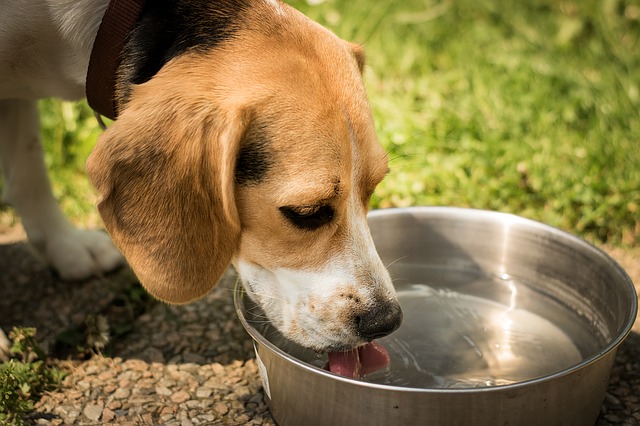Your dog must always have a bowl of clean, fresh water at his disposal because he has the ability to regulate his water consumption according to his needs.
Heat, intense exercise or certain foods can accentuate the feeling of thirst and the need to hydrate.
However, if you find that your dog is drinking a lot more outside of these patterns, this should alert you.
Indeed, an increase in thirst often associated with an increase in urination can reveal an underlying disease.
We speak of polyuro-polydipsia syndrome (PUPD) to designate an animal, dog or cat, which drinks and urinates more than normal.
In general, the dog affected by this disorder becomes messy at home because he cannot hold back his urine, which has become too heavy.
To find out why your dog is drinking a lot and how to help him, here’s everything you need to know about thirst in dogs and the different causes of this behavior .
Thirst, a natural process

The main reason humans and animals drink is…thirsty. It goes without saying!
Indeed, when our bodies have a lack of water, we drink to compensate for the losses.
As for dogs, since they do not sweat, except in very small amounts through the pads and snout, they eliminate body heat by panting.
When they pant a lot, they lose water through evaporation .
This water loss is physiological and can be easily regulated by drinking.
Excessive water consumption, higher than normal, or produced for no apparent reason, can thus be the alarm signal that something is wrong.
There are indeed many reasons why the body is not able to control water loss, even at normal temperatures.
Either way, this water loss needs to be replenished and dogs need to drink a lot more than usual to regain balance.
My dog drinks a lot: How much water does a healthy dog drink?
As a general rule, water intake varies slightly with diet.
If dogs are fed wet food, they may drink less, while dogs fed dry food or salty treats need to rehydrate more and thus appear to drink more than the norm.
However, this water consumption should always be physiologically normal.
To get a general idea, it is said that a healthy dog should drink between 20 and 70 ml/kg of body weight per day .
Being aware of how much water your dog is drinking is important because drinking too little water can lead to dehydration but also indicate organic disease…just like drinking too much.
Also, if your dog is drinking more than usual, he’ll probably urinate more, which can be another sign of a health problem.
My dog drinks a lot: The 7 main causes
1. Polydipsie psychogène
Psychogenic polydipsia is an uncommon cause of excessive water consumption.
This compulsive drinking reflects a behavioral disorder that can be similar to bulimia in the food sphere.
Drinking too much can then be a way for your dog to externalize his discomfort, his boredom , his stress or his anxiety.
2. Medicines
Certain medications, such as cortical steroids ( prednisone for example), often have the side effects of increased thirst and urination.
This class of drugs is prescribed in particular against rheumatism, allergies and autoimmune diseases.
If your dog is on medication, drinking and urinating a lot may be related to medical protocol.
3. Kidney failure
Kidney failure in dogs is defined as a dysfunction of the kidneys which no longer carry out their mission of filtering waste, maintaining the balance of electrolytes and water and producing hormones.
The disease can take an acute form or a chronic form . Only the chronic form causes PUPD.
Note that other kidney diseases can cause thirst and excessive urination such as Pyelonephritis or Renal Glycosuria.
4. Diabetes mellitus
Diabetes mellitus is characterized by a chronic increase in the level of sugar (glucose) in the blood.
Several forms of diabetes exist requiring specific care.
Obesity is the most common cause of this disease which causes, among other symptoms, increased water intake and urination.
Dr. Magali Decome , veterinarian specializing in internal medicine, talks to us, in pictures, about diabetes in dogs and cats.
5. Diabetes insipidus
Diabetes insipidus is totally different from diabetes mellitus since it refers to an anomaly in the production or effectiveness of antidiuretic hormone (or ADH) in dogs and cats. This anomaly will generate the PUPD syndrome.
6. Cushing’s syndrome or hyperadrenocorticism
Cushing’s syndrome is a fairly common hormonal disease characterized by excessive secretion of cortisol , a hormone produced by the adrenal glands.
It is also called hypercorticism or hyperadrenocorticism.
Two forms exist:
- The pituitary form which is the most frequent, caused by a tumor of the pituitary gland, most often benign and small in size.
- The adrenal form which is caused by a benign or malignant tumor of one of the two adrenal glands.
Dr. Suzy Valentin , head of internal medicine, talks to us, in pictures , about Cushing’s syndrome in dogs and cats.
7. Pyometer
A pyometra is an infection of the uterus in bitches that have never been pregnant. This disorder develops after a heat cycle and must be treated early for a good prognosis.
Increased water intake and urination is one of the symptoms of infection.
Surgical intervention is recommended to achieve the removal of the uterine horns and ovaries.
How to deal with increased thirst and water consumption?
Drinking excessive amounts of water often leads to urinary consequences. Although drinking a lot of water is not necessarily a sign of a health problem, urinating more can be a real problem, as affected dogs often defecate improperly.
My dog drinks a lot: what to do?
Consult your veterinarian
The first and most important step in combating excessive water intake is to diagnose and confirm (if present) an underlying disease with your veterinarian.
Most diseases are insidious and slow-developing, so caution should be exercised.
We will keep repeating it! Make an appointment with your veterinarian as soon as possible so that he can examine your companion to establish a diagnosis.
First, he will perform a number of blood and urine tests.
Additional tests may then be necessary to better identify and regulate the disease.
Remember that the only way to reduce water intake is to manage the underlying pathology.
The good news is that most of these conditions can be fixed and once your dog is treated, he can go on to lead a normal life.
But again, if you have any questions or concerns, you should always consult or call your practitioner – they are your best resource for ensuring the health and well-being of your pets.
And don’t…
– Never restrict access to water in order to reduce water consumption. Water restriction can lead to dehydration and fluid imbalance which will worsen your pet’s condition.
– Never ignore the problem . The causes of these changes can be very serious, even fatal.

